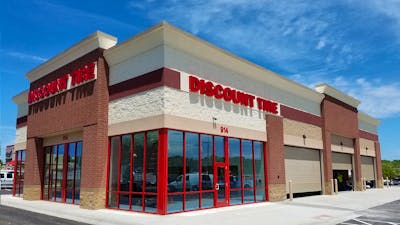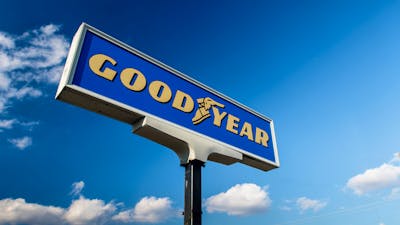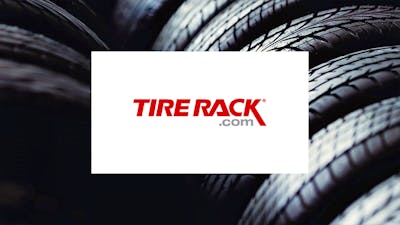Best Tires for the Ford Fusion
The Ford Fusion is a popular mid-sized sedan in the industry today. The vehicle is thought of as a reasonably priced family-friendly ride with good fuel efficiency. When it comes time to replace the original tires on your Ford Fusion, the vast array of choices can be confusing.
Get the Best Deals on Tires
The best times for the Ford Fusion will depend on your driving style, where you live and what you want for your vehicle. Here, we will break down your best options based on trim level, size, budget and the needs of the driver.
Have an older Ford Fusion? See tire sizes for previous years.
Best Tires Per Tire Size: Economy, Mid-pack and Top-Tier
The following are all-season tires, each of which go beyond the original specifications set out by the manufacturer.
Economy
Think high value here - you will still get a lot for your money while keeping your budget in check.
P235/50R17 96W General GMax AS-05
Staying Eco-focused is difficult in this price range, so focus on good traction and treadwear - which is precisely what you get with the AS-05.
- Wet and dry traction
- Cornering performance
- Cold weather performance
P235/45R18 94V Kumho Solus Majesty 9 TA91
Don't let the name dissuade you - this newer tire is from a proven company with roots in providing major manufacturers with original equipment tires - the value quotient is high.
- Longevity
- Low noise
- Cold weather performance
P235/40R19 96W Dunlop Signature HP
Balancing performance characteristics with good treadwear is hard to achieve in this range - get it when you can!
- Wet and dry performance
- Cornering performance
- Noise increases as tires age
- Firm over potholes and road irregularities
Mid-pack
This is your Goldilocks Zone - where price and performance are equally weighted.
P235/50R17 96V Continental Pure Contact LS
This one stays in the same vein as the OE tire - having an ECO focus which is designed to maximize fuel economy by providing lower rolling resistance. The primary benefits of this tire are very good dry and wet performance combined with high levels of comfort and treadwear.
- Cold weather/snow performance
- Low noise
- Not as cushioned a ride as competitors of the same size
P235/45R18 94Y Continental Extreme Contact DWS06
A highly rated tire that's kissing the upper echelons of performance characteristics while providing a great value. Developed over many years, this second-gen Dry Wet Snow (DWS) tire is hard to beat, especially when considering the included 1-year of road hazard warranty from the manufacturer.
- Ride comfort
- Tread life
- Softer sidewall
P235/40R19 96V Cooper CS5 Ultra Touring
A well rated tire that does that will handle everything you throw at them and come back for more.
- Four-season traction
- Smooth ride
- Wet braking
Top Tier
The following tires can be considered when that initial hit to the pocketbook takes a backseat to performance, comfort and treadwear.
P235/50R17 96H Michelin Premier A/S
Performance, control with a fuel-economy focus - the total package. Michelin has been able to develop a tire combining all of these attributes leaving you wanting nothing.
- Wet performance
- Smooth ride
- Price
P235/45R18 98Y XL Michelin CrossClimate+
An amalgamation of dry/wet performance with long tread expectancy and high levels of comfort make this a no-brainer from a company with a proven track record (literally).
- Wet and Dry performance
- Extended treadlife
- Cold weather performance
P235/40R19 96V XL Pirelli Cinturato P7 All Season Plus II
The second-generation of a proven performance all-season tire. Outstanding dry and wet performance that is blended with exceptional comfort and treadwear - a difficult combination to achieve indeed.
- Steering response
- Low noise
- Winter performance
- Price
What Drove Ford to Choose the OE (Original Equipment) Tires for the Ford Fusion?
It was a tug-of-war between the engineers and the bean counters and perhaps influenced by those who got the better golf score at the last executive outing. Ford has to try and figure out who their target audience is and how they will be using their Fusion. But they cannot know YOU, and this is where your personal preferences and goals will help guide you into your next set of vehicular shoes.
Original Equipment Tires (SE Trim)
- P235/50R17 96H Michelin Energy Saver A/S (ECO focued)
- P235/45R18 94V Goodyear Eagle LS-2
Original Equipment Tires (Titanium Trim)
- P235/45R18 94V Goodyear Eagle LS-2
- P235/40R19 96V XL Continental ContiProContact
Your Ford Fusion AWD was equipped from the factory with two different tires – depending upon the trim level. The OE tire was chosen to best meet the performance criteria set forth by the engineers and to fall into the budgetary constraints of the accountants. To that end, they chose what you see on your Fusion, as it rolled off the assembly line.
Optional Tires Sizes
Where you drive, how you drive, predominant weather where you live are some of the factors that will help determine if you are to change the tire (and wheel) size on your Fusion. In this particular case, you can go as far as Minus 2 and up to Plus 1 (those numbers are how much you change the diameter of the wheels going on in relation to the factory size). These optional tire sizes will strive to maintain the overall diameter of the tire such that they will maintain the rotational speed and thus speedometer reading you see. You don't want to change the overall diameter too much, unless you really enjoy a potentially lively interaction with your local traffic enforcement officer - you can fool your speedometer into thinking you're going slower or faster than you really are all based upon how fast your tires are turning. So stick with the proven combinations!
- P215/60R16
- P235/50R17
- P245/35R20
Pros and Cons of Alternative Tire and Wheel Sizing
Why choose a different size of tire? Depending upon how you'd like to alter your vehicle's capabilities will determine if going to a different size will be beneficial to you. A narrower tread and taller sidewall tire can help in the snow, while a wider tread, shorter sidewall tire can help improve road feel and steering response. By having a specialized set of tires and wheels, you'll now be able to expand upon the performance and environment range of your whip.
Keep in mind here, by changing the mounting diameter of the tire, you will need to budget a set of new wheels to match. But the money is but one factor to consider. Where to store a set of tires and wheels while they are not in use is another. Tires and wheels should be protected from direct sunlight, high levels of humidity and of course foreign objects that can damage them while in hibernation. If you have the space, then carving out a seasonal residence for them won't be a problem - but if square footage is at a premium, then you may need to invest in protective tire carriers and perhaps a rack to store them on, out of the way.
Conditions used: All seasons, Summer only, Winter only. Tires - they're the last interface between your car and the road surface, whatever that surface may be. So choosing the right tire will go a long way towards ensuring you stay shiny side up and keep you from having "that" conversation with your insurance agent. The majority of vehicles sold today are equipped from the factory with an all-season tire and as the name suggests, these types of tires are designed to work in all conditions - well most anyways. That's where specialized winter or summer tires come into play. A winter tire is designed to work in very cold conditions where snow and ice are prevailing road surfaces. Contrast that with a summer-only tire that will maximize performance in dry, hot conditions with very good wet weather performance. Choose wisely.
Priorities of Tire Characteristics
Dry, Wet, Snow, Ice, Noise, Longevity, Run Flat
Once you have chosen the particular type of tire you want to go with, to narrow down the choices you will then have to prioritize what characteristics are most important in that tire: Dry, wet and snow/ice performance are tempered by road noise, comfort and tread longevity. There is another factor that can be a deciding factor and that is whether or not the tire is designed to be run on flat otherwise known as runflat. While most people will choose a runflat tire if their vehicle was originally equipped with such (as those vehicles will not have a spare tire), you do have choice to equip with a non runflat.
Typically, the more specialized a tire is (extreme summer or winter performance) the greater the corresponding trade offs will be as well - higher performance will usually result in shorter tread life, more noise and less comfort. This is where a significant amount of research time will be spent in trying to ensure you don't make the wrong decision that can last until you need another set of tires.
When Should You Replace Tires
There are several different reasons why you will need to replace your tires, mainly the remaining tread depth and the age. Typically, both the minimum tread depth and maximum age will arrive together, and you need new shoes. The obvious single factor is tread depth - if it gets too low, then the tire's ability to resist hydroplaning is greatly reduced and can easily result in loss of control. Typically the minimum figure of 2/32" (or a little over 1.5mm) is the hard cutoff for tread depth - this minimum is also represented on a tire in the form of a "wear bar". It's a visual indicator that if this wear bar is level with the top of the tread, then it is time to pull the trigger. The other singular factor is age, and this is where the topic can be a little muddy. Many manufacturers use 5 years as the maximum age that a tire should reach and still be on your car or truck, others will say longer.
There is no hard, fast rule that will dictate at what age you should replace your tires, but once again, there can be visual indications that your tires are too old - and that's dry rot. Dry rot is the appearance of cracks in the surface of the rubber indicating it is deteriorating, losing its ability to grip the surface of the road. Some dry rot can be so bad that the cracks extend all the way down to the inner construction of the tire - such that the cord can be seen. If this is the case, then it's definitely time to replace. Ultimately let the driving dynamics be the deciding factor if the appearance is not telling - if you feel that the traction isn't what it used to be, then replace.
Tire Sizes By Year
| Year | Trim | Size |
|---|
Shop Tires Online and Save
Online tire prices are usually less than in store














